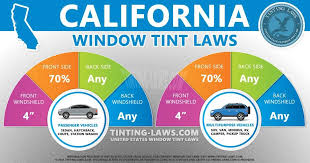Introduction: Navigating California’s Window Tint Regulations
Window tinting is a common vehicle enhancement that offers benefits like UV protection, increased privacy, and a cooler interior. However, in California, not all tinting is created equal—there are strict laws in place to maintain road safety and visibility for law enforcement. Understanding these rules is essential for every driver who plans to tint their windows. This guide explains everything you need to know about California’s tint laws, including what’s legal, what’s not, and how to avoid penalties.
Legal Tint Limits in California
California law specifies how dark and reflective your window tint can be, based on the window’s location on the vehicle. The front side windows must allow more than 70% of light to pass through. This regulation ensures that drivers maintain visibility and that law enforcement can see inside the car during traffic stops. The windshield may only be tinted along the top four inches with a non-reflective material.
On the other hand, rear side windows and the back window have fewer restrictions. Drivers can use any level of darkness as long as the vehicle is equipped with dual side mirrors that provide a clear view behind the car.
California also restricts the use of red, blue, or amber tints, and prohibits reflective or mirrored finishes on all windows. These rules are designed to reduce glare and distractions on the road.
Medical Exemptions for Special Conditions
The state allows medical exemptions for individuals with specific conditions that require limited exposure to sunlight. People with diseases such as lupus, porphyria, or other photosensitive conditions may apply for an exemption that permits darker tints or protective film on their front windows.
To qualify, a physician’s or optometrist’s note must be submitted to the California Department of Motor Vehicles (DMV). It’s important to remember that even with a medical exemption, the film must be clear and colorless—it cannot obstruct the driver’s view or affect the safety of vehicle operation.
Penalties for Non-Compliance
Violating California’s tint laws can lead to fines and legal issues. First-time offenders typically receive a “fix-it” ticket, giving them the opportunity to remove or replace the illegal tint and show proof of correction.
Failure to correct the violation or repeated offenses may result in increased fines and the classification of the issue as a non-correctable offense. In severe cases, non-compliance could even impact vehicle registration or insurance rates.
To avoid these issues, it’s best to ensure any modifications are within the legal limits before installation.
Choosing a Compliant Tint Installer
When tinting your vehicle, choose a reputable and licensed tint shop that understands California’s specific regulations. Ask for a certificate of compliance and make sure a sticker indicating the VLT percentage is applied to each tinted window. This will help confirm that your tint meets state standards and can serve as proof during a traffic stop.
Conclusion: Stay Legal and Drive with Confidence
California’s tint laws are in place to protect both drivers and law enforcement. By understanding what’s allowed and what’s not, you can enjoy the benefits of window tinting without facing fines or legal complications. Whether for comfort, privacy, or health reasons, always ensure your window tint complies with California regulations—your safety and peace of mind depend on it.



